Ways to implement blocking scalability
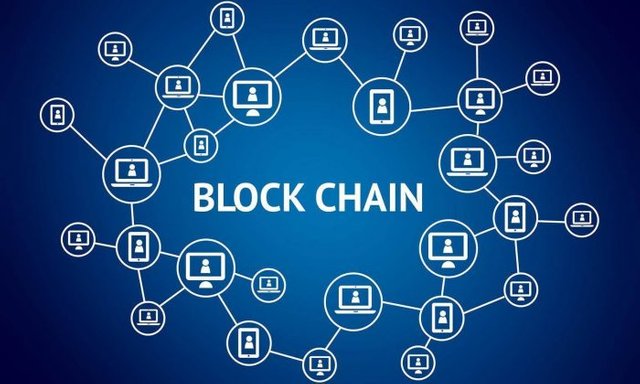
Scalability has long been a major obstacle to the spread of digital currency. Even today, no one knows how to achieve the same transaction speed per second as PayPal or Visa. The founders of various digital currency projects argue that someday the whole world will use their "currency", but they can not imagine a reliable plan for scaling the network of their currency to the required level. Even Satoshi Nakamoto, the founder of Bitcoin, seems to have simply assumed that advances in technology of equipment and communication networks will solve the problem of scalability instead. Dash is the first digital currency with a ready answer to the question of scalability, without the use of a non-existent technology, which probably will not appear. Dash will be able to compete on a par with PayPal and VISA,
The two-tier network Dash has shown a number of advantages over several years, and has contributed to the creation of such important technologies as InstantSend, PrivateSend and decentralized management. Now there are over 4000 motivated master nodes supporting the second level of the network. And so, as these Masters get a part from the extracted blocks, their owners can afford high-quality VPS equipment for hosting Masterdn. Thus, a high-quality decentralized network infrastructure is built. Using the Masterdn system, Dash will be able to scale much faster than any other project. The first version of Dash Evolution will support 500,000 users daily, and in about three years the network will be able to withstand 50 million users. There is a document explaining how this unique project will be implemented.
A lot of existing projects believe that block-scaling is impossible. It's then that they did not explore alternative P2P architectural solutions to improve performance. We intend to show how far a motivated second-level architecture can develop such a project as Dash.
This is how our network looks today, when its first and second levels work together.

From a virtual server (VPS) to a server farm
Dash already attracts considerable interest from well-known companies wishing to implement new products based on it. Since these companies are interested in Dash now, we understand that we must implement scaling immediately. When the first version of Dash Evolution is released next year, we expect only increasing interest to us and, therefore, we must be confident in the ability of the network to immediately cope with the increased load. To fulfill our scalability goals, Dash will start supporting 2MB blocks starting from the 4th quarter of this year. We intend to scale the network before it reaches the maximum possible bandwidth. We must act on the lead.
The first version of Dash Evolution, which we expect in 2018, will support 5MB blocks. We believe that the incredible features and ease of use that we have built into the Evolution platform will create a sharp increase in demand for our network services. We want to make sure that we have sufficient transaction capacity to meet these additional requirements. The second version of Evolution will support 15MB blocks, using the specialized hardware developed by Dash Labs for Masterdn. Most likely we will use the resources of GPUs for the necessary processing of blocks, effectively creating the first version of the hardware part of our "super-large block accelerator" (ULBA). In the final stage, the third version of Evolution will support 45MB blocks using specialized PCI-EX cards,
This is how the network will look after the upgrade.
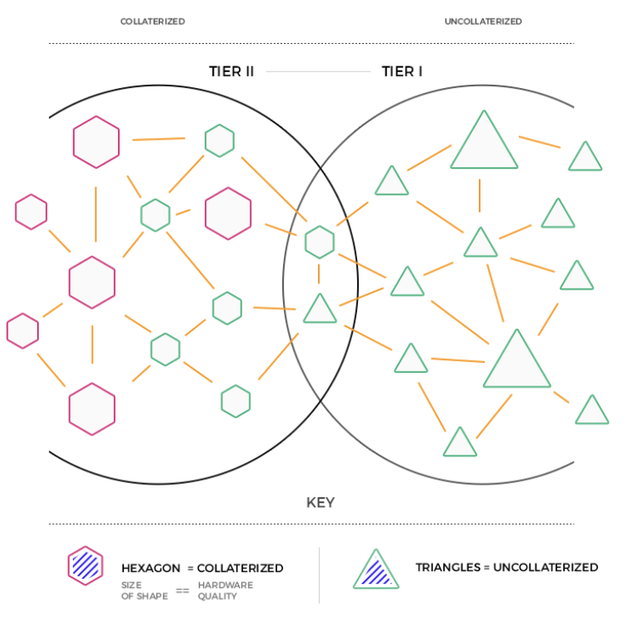
Theoretical questions
It is reasonable to ask, why did not other crypto-currency projects implement support for ultra-large blocks to scale throughput? The problem with large blocks is that each node must process each transaction within one block and then translate it into a network. Many digital currencies are based on altruism - ordinary users keep the network nodes free - just to support the network itself. Unfortunately, due to lack of economic incentive, such networks eventually run into the bottleneck of the slowest nodes. Dash solves this problem by financial encouragement of his Masterdn, giving them some of the found blocks.
The technical solution allowing to create a network supporting large blocks is three-step. First, it is required to provide each Masterod with high-performance equipment so that processing of each unit is almost instantaneous. Second, we need confidence that each Masterdnode is connected to a high-speed communication channel for broadcasting blocks to the network as quickly as possible. Third, it is necessary that the Masternodes on the second level of the network are as closely interrelated as possible and transmit each other blocks at the highest possible speed.
Even without specialized equipment, Masterdnodes are able to support blocks of significantly larger sizes, but with the availability of appropriate processors, RAM and hard disks. Therefore, we intend to launch the process of increasing the block size even before the release of the Evolution platform. Scalability is now a concern in the crypto-currency world, especially when some projects have problems with increased commissions and long time confirmation of transactions. Having started scaling the Dash network right now, we offer a solution to all these problems before they begin to affect our network.
Gavin Andresen before leaving the project Bitcoin conducted extensive work on the study of 20MB blocks. Based on his research, I came to the conclusion that our network can easily cope with both 20MB blocks and large blocks if we solve the problem of block translation in the near future. To get acquainted with the remarkable researches of Gavin you can follow the following links:
Http://gavintech.blogspot.com/2015/01/twenty-megabytes-testing-results.html
Http://gavintech.blogspot.com/2015/01/looking-before-scaling-up-leap.html
Based on these and our own research over the past year and a half, we propose here such a plan for upgrading the Masterdn network:
Stages of modernization Masterod
Stage I - V13 : Standard VPS servers that need to be upgraded to a relatively high level of performance without the need for additional special equipment. This will support blocks up to 20MB.
Stage II - V14 : Specialized computers with high-performance multi-core processors, assembled in server racks for rapid transmission of blocks and minimizing any delays.
Stage III - V15 : Use of video processors. The nVidia Tesla GPUs have programmable CUDA processors. The following model consists of 448 such cores, which will allow the Master Wizards to process cryptographic signatures for each transaction in parallel. Also we will create small scripts to speed up various tasks of the Dash-Core client, redirecting some resource-intensive processes to the Masterdn network.Outline
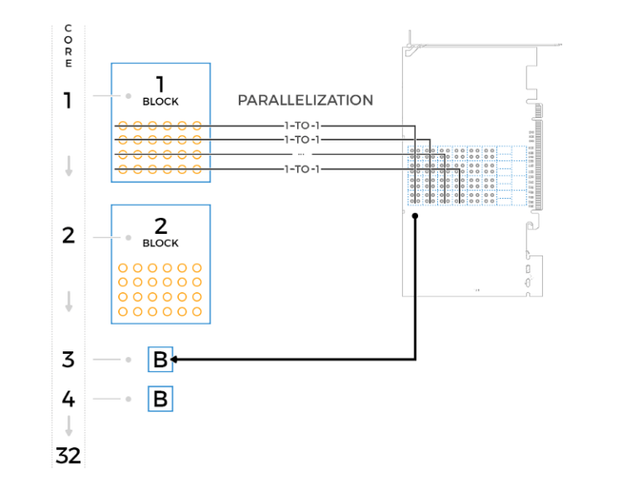
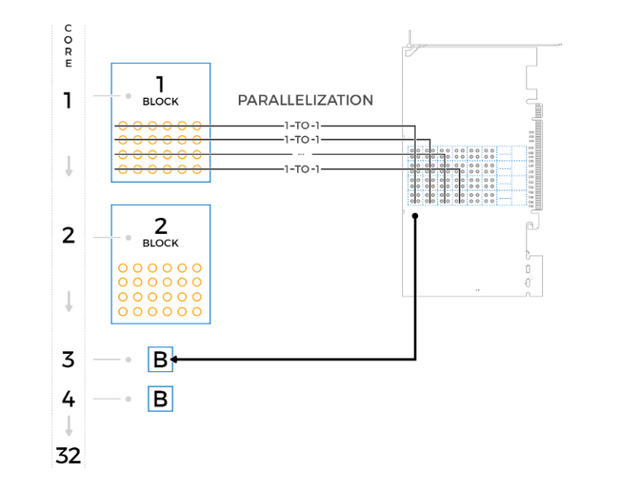
Http://www.nvidia.com/docs/IO/43395/NV_DS_Tesla_M2050_M2070_Apr10_LowRes.pdf
Stage IV - V15 : ASIC on PCI-EX peripheral equipment. Just as the miners moved from the CPU to the GPU, and then to the specialized ASIC devices, the Master DASH network will follow the same path of modernization. At this stage, we will create specialized ASICs in the form of peripherals on the PCI-EX or external devices on the USB 3.0 bus. The first generation of ULBA devices will have a high density of deployment and is aimed at specific versions of the Dash Core client.
ULBA devices inside the equipment for Masterdn will take on specific functions, providing 10 and 100 times the speed increase in comparison with the calculations on the GPU. The creation and development of this equipment will be completely open (open source), and the network itself will finance the financing. This will reduce the desire of private companies to launch the production of proprietary equipment to obtain only economic benefits without worrying about the status of the network.
In short, switching to blocks larger than 20MB will require a whole set of special equipment from each Master. This equipment must have the features of redundancy, fault tolerance, load sharing, parallelization of GPU calculations, special PCI-EX equipment and an array of hard disks to increase the resiliency of the network data store. Masternodes will support two types of hard disks, conventional spindle disks with a large amount of data and solid-state disks for accelerated read / write operations that is critically important for storing the block and cache.
Stage V : New versions of ULBA devices will use advanced silicon chip manufacturing technologies, low density of chip placement and fiber-optic communication of all Masterdn. At this stage, network services such as block browsers that require full block validation will be launched.
Let's point out the differences!
Miners and anyone who wants to move full data across the network will need powerful servers and a channel with high bandwidth. They will need the same powerful equipment as the Masternodes in the network use. This will improve the privacy of the network, because tracking will become too expensive.
Of course, there is a risk that the miners, faced with additional costs for equipment, will find further mining unprofitable. They will have to bear the costs both for the Miner and for the maintenance of the Master-Code, and the process of mining will yield the same profit as before. Miners who can not or do not want to upgrade the equipment will find an increasing number of Orphan blocks (correct blocks being late in time to broadcast themselves), which will seriously reduce their profits.
We will solve this economic problem through a system called "collateral mining". Simply put, we integrate mining with the Master DASH network. Working on special equipment, the Master-Ladder will run the mining program in parallel. It is this combination of Masternode / Miner that we call "collateral mining". The hashing power of the participant will be determined by the number of his belonging to Masterdn. Before the obligatory adoption of the confirmed by the pledge of mining, a transition period will be announced, during which yesterday's miners will be able to repay the initial capital expenditures for the equipment.
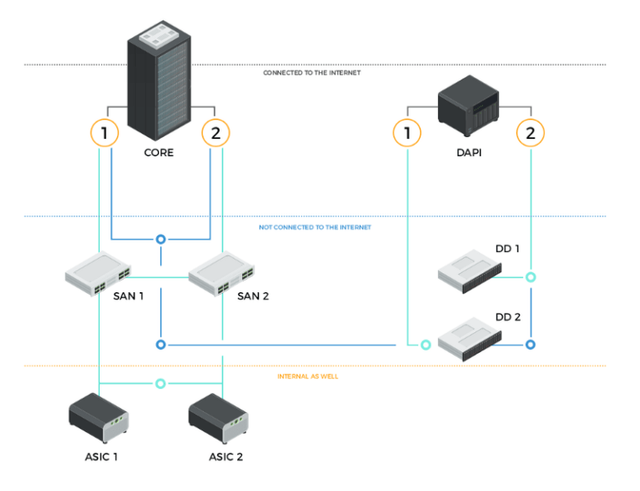
Aspects of Economics and Capacity
The main principle of the pledge mining is the requirement of confirmation of the pledge and the existence of a special mining key associated with each Masterplan intending to extract the blocks. Thus, each Masterdn can produce only a certain number of blocks at a specified time, creating in the network the effect of robin mining (a cyclic transition from a failed pool to an active one)
This approach has many useful advantages:
Reduced power consumption
Uniform distribution of the shares of the share solution for each Masternode
Protected hashes for running quorums
Quick block processing
Accelerated distribution of blocks
Supports extra-large blocks
Full protection against attack 51%
Eliminating Mining in Pools
The speed and bandwidth of the channel will be overshadowed by the increased interconnectivity and speed of Ethernet in the Dash network.
We believe that the Evolution platform will deliver our project on par with Satosh's original vision of a decentralized digital currency. Quoting Satoshi:
"A modern system, where each user is a network node, is not an acceptable configuration for a large-scale network. It's as if every Usenet user had his own NNTP server. Users should be just users. The more difficult to maintain a node, the fewer nodes will be on the network. These remaining multiple nodes will become server farms. The rest will be client nodes, capable only of carrying out transactions, without any generation. " - Satoshi, 2010
The first level (end users of the dash-core client) will be naturally decommissioned, and users will be able to access the network only through our decentralized API (DAPI). We call DAPI the third layer of the network.
Stages of transition to collateral mining
We will transfer the network to the lien mining gradually, ensuring the security of the network and at the same time allowing the existing miners to return the costs for the mining equipment. Modernization of the network will take place in several stages:
Stage I: Standard Miner / Beginning of Mining Organization
Step II: The Master key for the Master-Code as an additional function
Stage III: Mandatory Minor Key for the Master-Ladder
Stage IV: Required ASIC with core daemon for the Master
Keys for Masterdn - technical features
Masternodes will use different keys to sign each action. Now the Master-Ladies use the same key for each action. In the future, they will need to delegate a special key to the contractor who will mine on behalf of this Master. Such a mechanism will ensure that the contractor can not perform any other actions except mining, for example, he will not be allowed to vote. (Note: this only applies to the Masterdn key, the key storing the 1000 Dash deposit is always hidden.)
Current use of keys:
A + B | Master key public key / Signature key
Future use of keys:
A + B + C + D | The public key of the master key / key for signing messages on the network / The voting key / The key for mining.
11